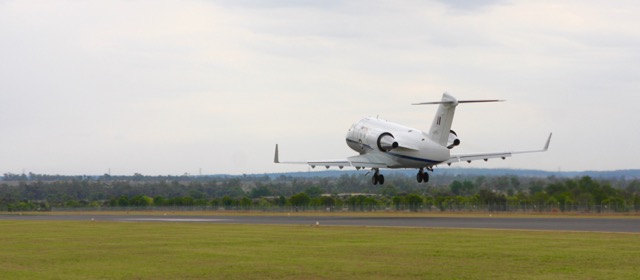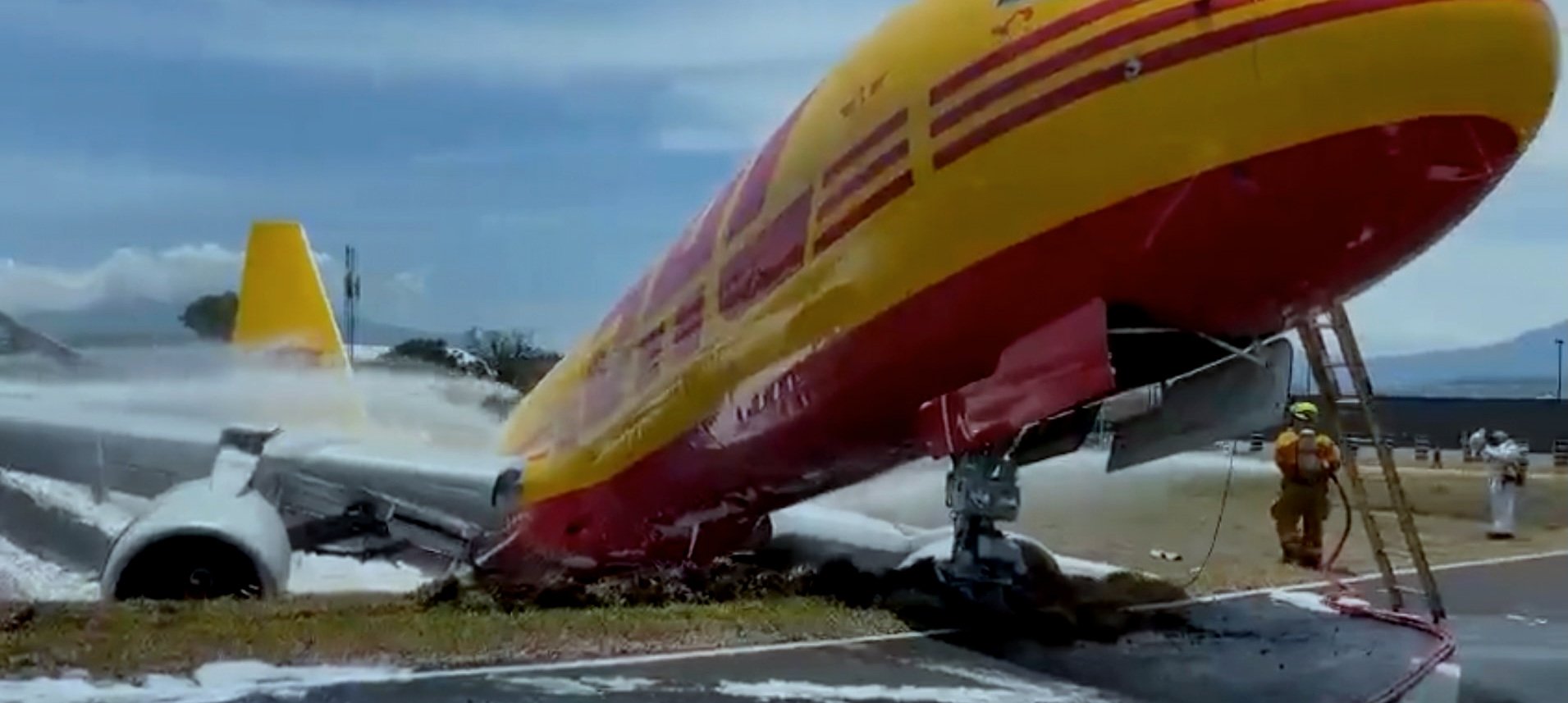
Posts about stuff relating to airports

Runway Strip Excursion: Bad Luck or Unintended Consequence?
A little over a week ago, there was another spectacular runway excursion event caught on film and shared across social and traditional media. On the 7th April, 2021, a DHL 757-200 veered off the runway at Juan Santamaria airport in Costa Rica. The aircraft was returning to the airport after declaring an emergency due to a hydraulic issue. The aircraft appeared to have landed safely but towards the end of its roll-out, it veered to the right and came to rest in a low area with its nose high and tail broken. Luckily, this was a freighter flight and the crew evacuated safely.
Header image: Grabbed off Google

Is this Acceptable? When a runway strip isn't wide enough
This week, on Sunday, 14th January 2018, a Pegasus 737-800 veered off the runway at Trabzon, Turkey and came to rest on a steep slope quite close to the Black Sea. Obviously, it is way too early to speculate on the causes of the accident but as airport safety nerds, I think its okay for us to have a look at the role the runway strip played in this event. a few internet comments have questioned the compliance of the runway strip and it does look narrow. However, if Google Earth is to be believed, these comments and first thoughts might not be correct.

Wrong, but not as Wrong: Wellington RESA “Final” Decision
Earlier in 2017, the New Zealand Court of Appeal reversed an even earlier court decision and found that the NZ Civil Aviation Authority’s (CAA) Director had made an error in assessing the Runway End Safety Area (RESA) length requirement contain in Civil Aviation Rule Part 139 - I blogged about that decision here.
This week, the NZ Supreme Court handed down its judgement on the appeal made by the NZ CAA and Wellington Airport. Not a bad turnaround considered the length legal battles usually take.
And I guess, technically, the NZ CAA and Wellington International Airport Ltd (WIAL) lost. The appeal was dismissed and costs were awarded but the reasoning included in the judgement does provide the NZ CAA with at least a partial win.

Integrating Runway Safety Teams with your Safety Management System
I've just spent an amazing week in Bali1 workshopping with operators and regulators from the Asia-Pacific region (and some from further afield) on the issue of runway safety. We got a lot of good information from the Flight Safety Foundation, ICAO and COSCAP as well as airlines, airports and regional regulators.
The primary objective of the week was to provide information on and practice in the establishment and conduct of Local Runway Safety Teams (LRSTs). To this end, the seminars and workshop were great but I left feeling like one connection had been missed. The final question on my mind and many others, I am sure, was:
How do these runway safety initiatives integrate into my SMS?

BTII: Control-freak*
As a follow-on to my first post on the Bow-Tie risk assessment method, I thought I'd concentrate on controls (or barriers or whatever else you would like to call them). This is, after all, where all the action happens. Risk controls are how we spend most of our time - they are the practical aspect of managing risk.

BTI: Dressing up for Risk Assessments
I've been doing a lot of pondering on the Bow-Tie method of risk assessment for a project at work. Bow-Tie is a tool used by many, especially in the oil & gas industry, to create a picture of risk surrounding a central event. It's got a few positives and a few negatives but these can be overcome if you understand the limitations of the model being used.

Integrating Runway Safety Teams with your Safety Management System
I've just spent an amazing week in Bali1 workshopping with operators and regulators from the Asia-Pacific region (and some from further afield) on the issue of runway safety. We got a lot of good information from the Flight Safety Foundation, ICAO and COSCAP as well as airlines, airports and regional regulators. The primary objective of the week was to provide information on and practice in the establishment and conduct of Local Runway Safety Teams (LRSTs). To this end, the seminars and workshop were great but I left feeling like one connection had been missed. The final question on my mind and many others, I am sure, was:
How do these runway safety initiatives integrate into my SMS?
Image: Agência Brasil

Wrong Runway, Go'Round
If you're not into aviation, like most Australian airport operators, you might think that some of those stories you hear from fanatics like me are a bit far-fetched. In my early days in aviation, I thought the same about the stories involving pilots putting their aircraft down on the wrong runway. Surely not...
Unfortunately, it has happened with the latest incident occurring less than two months ago. This time it involved a CRJ-200 and a new but not yet operational parallel runway. Luckily, according to this site, no one was injured.
Header image: William Mattey (via Pexels)

Runways Made Safer? Yeah but…
I caught this story on the web last week. According to the press release (eh, I mean) article, aircraft are falling apart during take-off and landing and the frontline of defence, airport safety officers, are prone to error. Enter the saviour – FOD radar. Okay, that's a cruel, exaggerated (mis)representation.
I will admit that Foreign Object Debris (FOD) is a very real problem for aviation and airports, in particular. Skybrary puts the yearly cost at $4 billion per year (including wildlife) and the list of FOD-induced crashes is often headlined by the 2000 Concorde disaster.
It's the mis-characterisation of runway inspections that gets to me as it seems that the article is trying to paint the following picture:
Image credit: Darli Donizete (via Pexels)

Guyana & Runway Safety
This week's news of a runway excursion in the South American country of Guyana got me thinking of the current focus on runway safety. So, I turned my mind to writing something on the subject. Unfortunately, I turned too slowly and Andy Pasztor at the Wall Street Journal beat me to it! Thats what I get for having a day job :(.
Header image: Jonathan Borba (via Pexels)

Low Visibility Operations
Greetings from Jakarta! Tomorrow I'll be facilitating a training workshop which is tasked with a risk-based review of low visibility standards. To be honest, I'm really looking forward to it. To help with the workshop, I've been surfing youtube looking for videos of low visibility operations and I thought this one was one of the best.

St. Barth's Airport
On the face of it, no Australian airport should ever have obstacle problems. I mean, look at the space we have! But of course, we have the odd hill and good ol' urban encroachment means that some airports are struggling with obstacle control. Nothing like St Barth's airport though...

"a sweep of the runway collected more than 20 bird carcasses"
I spied a couple of news reports of a mass bird-strike at DFW Airport today and the above quote jumped out at me. The procedure for checking the runway following a bird-strike is not required under Australian regulations and is not always included in the aerodrome manual - despite being a really, very, really good idea.

Topic of the Month: Runway Safety
The stories surrounding runway safety (i.e. runway incursions, excursions etc.) have been coming out steadily in the lead up to and following the global runway safety symposium. The stats formed the call to action and the responses have included the technological, the educational, the multi-disciplinary and the collaborative.
